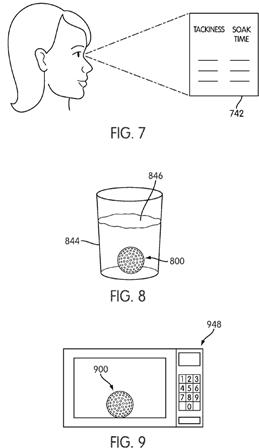Man that Ball is Tacky, Literally!
How tacky do you prefer your balls? Nike Golf has eyes on allowing golfers to adjust the tackiness of their balls.
Today a patent application published as US Pub. No. A golf ball is provided that includes a coating. The coating is designed to allow a golfer to modify or increase the tackiness of the coating. The coating changes tackiness when exposed to a soaking material. A method of determining a desirable length of soak is also disclosed.
OK, I am listening. The application goes on to explain:

BACKGROUND
[0002] Golf balls typically have an outer coating or top layer made of polyurethane. Commonly, this outer coating is made of SURLYN or a similar material. This type of material may be selected for a number of reasons, including elastomeric qualities that allow the ball to deform when it is struck by a club.
[0003] Golf balls as typically constructed usually cannot be modified by the user to change their properties. In some cases, the lack of modifiability is due to a desire to prevent the user from changing the ball’s properties in such a way that they no longer conform to USGA regulations. However, in other cases, it may be desirable to allow a user to modify the properties of the golf ball to enhance play, particularly when the ball is not being used in a competitive environment.
[0004] Among the obstacles that are faced by golfers is moisture on the course. Often the moisture takes the form of dew or rain on the grass and rain or other precipitation falling from the sky. This moisture can wet the ball and the club face. When there is moisture between the ball and club, the ball is likely to slip while in contact with the club more than when golfing in a dry situation. This slipping may cause the ball to have reduced spin after impact and may otherwise negatively affect the flight path of the ball.
[0005] In addition, other changes to a golfer’s clubs may affect the degree of slip between the ball and the club. For example, if a new set of clubs is used, the surface of a new club face may have a reduced friction because it has not been used heavily and become abraded. Further, if a golfer begins to use a club with a different groove profile, the coefficient of friction of the club face may be reduced.[0006] When these types of changes occur, it can cause a golfer to become flustered and mishit the ball to an even greater degree than caused by the equipment or conditions. Minimizing these effects may be helpful in the golfer having a pleasant golfing experience.
[0007] Accordingly, it may be desirable to provide a ball where the user can adjust the tackiness depending on the equipment and weather conditions. It may also be desirable for the tackiness to be varied depending on the golfer’s expectations of the day on which golf will be played.SUMMARY
[0008] In one aspect, a structure capable of being attached to another object is disclosed. The structure includes a coating layer, a substrate, and a securing structure. The coating layer is capable of changing in tackiness when exposed to a soaking material. The substrate has a first side adjacent the coating layer. The securing structure is on the second side of the substrate and is capable of securing the substrate to another object.
[0009] In another aspect, a golf ball includes a core and a cover radially outwardly of the core. A coating is radially outwardly of the cover and at least partially surrounds the cover. The coating is capable of changing tackiness when exposed to a soaking material.
[0010] In another aspect, a method of modifying the tackiness of a golf ball is disclosed. A golf ball is provided. The golf ball has an outer coating that is capable of changing in tackiness. The desired level of tackiness is determined. The length of time the golf ball must be exposed to a soaking material to achieve the desired level of tackiness is determined. The golf ball is exposed to the soaking material for the determined length of time.
[0011] In any of the embodiments, the soaking material may be a fluid. The fluid may be water. The soaking material may be microwaves, in which case, the ball may further include a shield layer capable of shielding at least the core from the microwaves.
I can’t decide whether this is a great idea or a crazy idea; probably because I have images floating around in my head of flies getting stuck to a tacky golf ball, and a really tacky ball landing in a bunker full of soft dry sand. My conclusion…. interesting, very interesting.
David Dawsey – The Golf Invention Attorney
PS – click HERE to read more posts about golf ball inventions
